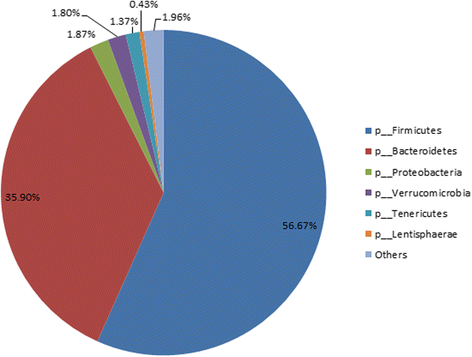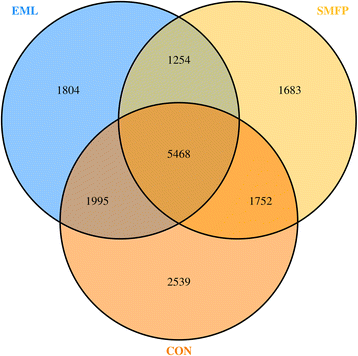Effect of ensiled mulberry leaves and sun-dried mulberry fruit pomace on the fecal bacterial community composition in finishing steers
- PMID: 28431497
- PMCID: PMC5401608
- DOI: 10.1186/s12866-017-1011-9
Effect of ensiled mulberry leaves and sun-dried mulberry fruit pomace on the fecal bacterial community composition in finishing steers
Abstract
Background: Here, we aimed to investigate the effects of ensiled mulberry leaves (EML) and sun-dried mulberry fruit pomace (SMFP) on fecal bacterial communities in Simmental crossbred finishing steers. To this end, the steers were reared on a standard TMR diet, standard diet containing EML, and standard diet containing SMFP. The protein and energy levels of all the diets were similar. Illumina MiSeq sequencing of the V4 region of the 16S rRNA gene and quantitative real-time PCR were used to analyze and detect the fecal bacterial community.
Results: Most of the sequences were assigned to Firmicutes (56.67%) and Bacteroidetes (35.90%), followed by Proteobacteria (1.87%), Verrucomicrobia (1.80%) and Tenericutes (1.37%). The predominant genera were 5-7 N15 (5.91%), CF231 (2.49%), Oscillospira (2.33%), Paludibacter (1.23%) and Akkermansia (1.11%). No significant differences were observed in the numbers of Firmicutes (p = 0.28), Bacteroidetes (p = 0.63), Proteobacteria (p = 0.46), Verrucomicrobia (p = 0.17), and Tenericutes (p = 0.75) populations between the treatment groups. At the genus level, genera classified with high abundance (more than 0.1%) belonged primarily to Bacteroidetes and Firmicutes. Furthermore, no differences were observed at the genus level: 5-7 N15, CF231, Oscillospira, Paludibacter, and Akkermansia (p > 0.05 in all cases), except that rc4-4 was lower in the CON and SMFP groups than in the EML group (p = 0.02). There were no significant differences in the richness estimate and diversity indices between the groups (p > 0.16), and the different diets did not significantly influence most selected fecal bacterial species (p > 0.06), except for Ruminococcus albus, which was higher in the EML group (p < 0.01) and Streptococcus bovis, which was lower in the CON group (p < 0.01) relative to the other groups.
Conclusions: In conclusion, diets supplemented with EML and SMFP have little influence on the fecal bacterial community composition in finishing steers.
Keywords: Ensiled mulberry leaves (EML); Fecal bacteria community composition; Sequencing; Sun-dried mulberry fruit pomace (SMFP).
Figures




References
-
- Famuyiwa O, Ough CS. Grape pomace: possibilities as animal feed. Am J Enol Viticult. 1982;33(1):44–46.
-
- Spanghero M, Salem A, Robinson PH. Chemical composition, including secondary metabolites, and rumen fermentability of seeds and pulp of Californian (USA) and Italian grape pomaces. Anim Feed Sci Tech. 2009;152(3):243–255. doi: 10.1016/j.anifeedsci.2009.04.015. - DOI
-
- Alipour D, Rouzbehan Y. Effects of ensiling grape pomace and addition of polyethylene glycol on in vitro gas production and microbial biomass yield. Anim Feed Sci Tech. 2007;137(1–2):138–149. doi: 10.1016/j.anifeedsci.2006.09.020. - DOI
-
- Pirmohammadi R, Rouzbehan Y, Rezayazdi K, Zahedifar M. Chemical composition, digestibility and in situ degradability of dried and ensiled apple pomace and maize silage. Small Ruminant Res. 2006;66(1):150–155. doi: 10.1016/j.smallrumres.2005.07.054. - DOI
-
- Alibes X, Munoz F, Rodriguez J. Feeding value of apple pomace silage for sheep. Anim Feed Sci Tech. 1984;11(3):189–197. doi: 10.1016/0377-8401(84)90062-2. - DOI
Publication types
MeSH terms
Substances
LinkOut - more resources
Full Text Sources
Other Literature Sources
Medical

